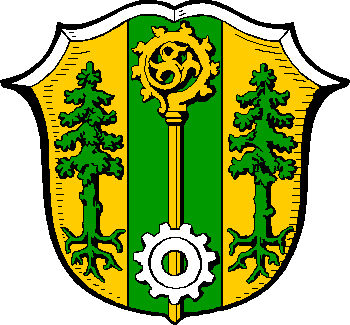 |
Forstern |
Or, a pale Vert charged with a crozier issuant Or, thereon a cog-wheel Argent, between two fir trees eradicated Vert. |
Foundation of the arms:
The origins of the village are tigthly linked to the former Benedictine abbey Ebersberg. In the late middle ages also here the usual fragmentation of land property began. However, the property of the cloister Ebersberg - transformed in 1595 into a Jesuitian college - remained dominating; in the 17th century more than two thirds of the premises belonged to it. The crozier in the municipal arms refers to these property relations. The name of the village, that can be explained as "at the forest people", is illustrated heraldically by the trees. Finally, in respect to the big industry then resident in the municipality the cogwheel became part of the municipal arms. Gear-wheels and cog-wheels as commonly understood industrial symbols have for a long time been taken over into the heraldic vocabulary.
The Bavarian Ministry of the Interior approved the adoption of the arms on May 18th 1953.
Design of the arms:
Emil Werz, München.
Landscape with coniferous forest around Forstern.
Crozier as a symbol for the cloister Ebersberg.
Big industry in Forstern: tractor factory Eicher.
Unser Bayern (Heimatbeilage der
Bayerischen Staatszeitung) Bd. 2 (1953), S. 47.
Oberbayerisches Archiv Bd. 78 (1953), S. 141, 143.
Press, E. et al. (1963): Im Zeichen des Pferdes - Ein Buch vom
Landkreis Erding. Erding (Landkreis Erding), S. 248.
Press, E. et al. (1963): Im Zeichen des Pferdes - Ein Buch vom
Landkreis Erding. Erding (Landkreis Erding), S. 185.
Landkreis Erding (Hrsg.) (1985): Landkreis Erding - Land und
Leute, Geschichte, Wirtschaft, Kultur. Erding (Landkreis Erding),
S. 338.
Erdinger Neueste Nachrichten
(Lokalteil der Süddeutschen Zeitung), 31.08.1994.
This webpage was last modified 2001-07-14 by Marcus Schmöger
Email: marcus@ed-wappen.de